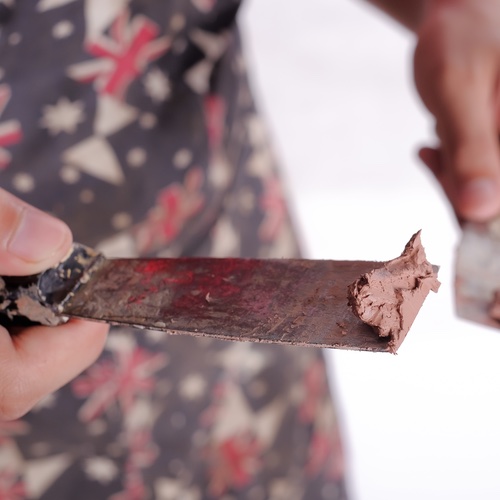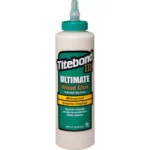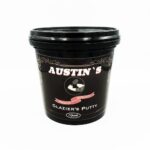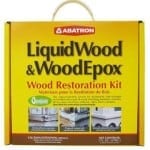
Having worked in the restorations trades for more than 20 years I have constantly been on the search for the best wood filler. I have tried countless products that at first seemed like a winner only to find, just like my high school dating experiences, they wouldn’t go the distance.
The conclusion I have come to is that there isn’t just one product, but rather a group of products that can handle any wood patching task I need. The best wood filler is sometimes not a wood filler at all, but a wood epoxy or even a putty. In this post, I’ll give you my take on the best products to patch wood on the market today.
The first thing you need to consider when choosing the best wood filler is what its use will be. Is it outdoors or indoors, painted or varnished, structural or cosmetic? There is a product for any need listed below, and you’ve just got to find the right one from the list below.
You can also read the results of my 5-year field testing of most of these wood fillers and epoxies at The Wood Filler & Epoxy Test (Year 5) to see how these products performed in the real world as well as to watch the video below.
MH Ready Patch
Best for small cosmetic repairs and surface leveling – MH Ready Patch is a great patch for a myriad of little patches. It doesn’t work for structural patches like an epoxy, but it does work quite well for things like nail holes and surface imperfections in painted wood (it’s not stainable). It dries fast, 30-45 mins and it’s ready to sand.
It is an oil-based product, but it cleans up with soap and water, which I love. I use it to fill holes smaller than a dime in size, smooth out alligatoring paint, surface checks, fill surface gouges or almost anything else I may need. Its only weakness is when you try to fill large areas which causes it to sag and shrink. Keep it limited to very small areas and always make sure you paint it because it will not last if left exposed to the elements.
LiquidWood & WoodEpox
Best for structural repairs or rebuilding of big portions of wood – There are tons of different types of epoxies for wood, but this product is by far my favorite because of its ease of use and long performance.
We use this every single day and my rot repair franchise Preservan uses a similar product by the truckload. The two parts work together to stabilize “punky” wood and fill in the missing areas.
The repairs can be sanded, drilled, planed, and essentially you are left with a repair that performs just like wood but will never rot or fall out. Epoxy repairs are some of the strongest, most long-lasting ways to patch wood. They are structural, so they can be used anywhere and are usually not troubled by water issues like other wood fillers.
Got some serious rot? This is the stuff you need. For info on how to use this awesome product, read my tutorial How To Repair Rotted Wood With Abatron Epoxy.
KwikWood
Best for small structural repairs in a hurry – Anyone who occasionally needs to patch wood should have a tube of this sitting in their shop or garage. This is a very simple to use 2-part epoxy that you mix with your hands. It’s kind of like squishing a tootsie roll together to mix both parts. Once you mix it, you have about 10 minutes before it starts to set up, and in 20-30 mins it is hard as a rock.
I use it to fill screw holes that have stripped out so I can get a sagging door hung again quickly or other tasks like that. Its fast drying time and resistance to rot and mildew make it perfect for exterior repairs too. I have used it outdoors and left it unpainted for years (not on purpose) with no problem.
Minwax Wood Filler
Best all-purpose wood filler – You knew I’d get around to an actual wood filler soon, right? Minwax Wood filler is such an easy to use and great product I am constantly surprised by how good it does for how little it costs. In the video above you can see the incredible results I got after a 5 year test with this stuff. It outperformed some epoxies and more expensive products big time.
It’s simple to apply with a finger tip or putty knife, sand when it’s smooth and prime when you’re done. No mixing to screw up. The fact that it’s not structural just means it should not be used for larger applications like the Abatron products above. It’s also a great option for stained and varnished projects as well as paint grade repairs.
Sawdust & Wood Glue

Best for color matching and flooring joints – This is a weird little trick that an old floor refinisher taught me and it really has worked great in very specific circumstances. Here’s how it works:
To patch wood using this method, you’ll need sawdust from the specific wood you are patching. Mix it with enough wood glue to get the consistency you need. You can make this a wet slurry and trowel it into the joints between old floor boards or make a thick paste to fill spots on damaged furniture.
You have to work fast enough that the glue doesn’t begin to dry on you, but to match the color of a repair for something that will be stained and varnished there is nothing better. Once it’s dry, sand the surface thoroughly and you’re good to go.
Austin’s Glazier’s Putty

Best for flexible joint filling – Glazing putty isn’t a wood filler, right? Wrong. For filling nail holes or joints glazing putty is actually incredibly useful.
Some glazing putties are bright white (DAP 33) which can hide well for painted trim, but are hard to see if you’ve gotten good coverage plus they can take weeks to cure. That’s why I created my own glazing putty with the help of the folks at Sarco Putty Co. that is usually ready for painting within just 24 hrs. It is also available in a brown color to blend in better for varnished projects.
For a better option to filling joints and ease of application you can’t beat a glazing putty. I can often use this in place of caulk for certain circumstances where more body is required than caulk which tends to sag.
What to Avoid
You’ll notice that there is one product I specifically did not include here that a lot of people use…Bondo. There is a good reason why it is not included in a post about the best wood filler and I’ve outlined why you should absolutely avoid Bondo when it comes to patching wood in this more in-depth post.
I’d love to hear what your experience has been with these products and if you have other favorites that you’ve found over the years. Are these truly the best products to patch wood or is there some other product that deserves the title of best wood filler.

Founder & Editor-in-Chief
I love old houses, working with my hands, and teaching others the excitment of doing it yourself! Everything is teachable if you only give it the chance.






I am going to paint the aluminum columns on my house. They are chipping paint. I am going to grind the paint off with an angle grinder, but it leaves alligator patches and other ugly patches. What would you use to make it look “perfect” when we paint them?
why don’t you try a chemical paint stripper first, that will loosen all paint on the column and then you can have a nice uniform surface
I use epoxy mixed with sawdust whenever the section I’m filling/patching is going to have to withstand stress. I first did this with some strandboard planks that were part of a waterbed. Some areas were heavily damaged by repeated installation and removal of screws over the 20 some year life of this bed. We were giving the bed to a relative, so I mixed up epoxy and then added sawdust until I had a thick and gooey paste that is more sawdust than glue. I then pressed the concoction into the missing chunks of wood a, laid a piece of wax paper over the goo, and then clamped a piece of veneer plywood on top. It worked great. I’ve now used this method many times. I’ve even used it to fill in missing chunks on competitive table tennis blades (the wood part of the paddle – they can run over $150, so hence worth repairing. So far all indications are that this makes a very durable filler that has a density similar to wood. Going forward, I’ll probably be using toughened epoxy from West Systems because it is more flexible than most others.
Next time screw the Oak together and counter sink your screw with a fostner bit. Then glue little dowel cutoffs with the direction of the grain. Sand and stain most people will not see the repair..
I’m repairing wooden pillars on a porch. They’ve been there 100 years or so and are rotting on bottoms. While porch repairs were ongoing, I Bondo’d, sanded, primed X 3, then painted X 5 five of the 16 pillars. My construction people were ready to put porch back together, said they’d repair & paint the remaining pillars. Three years later, I see they painted them but didn’t repair or prime or paint more than once. The 11 pillars ALL need the ORIGINAL repair & paint except now I have to do it with them in place, holding up porch roof. I am furious they didn’t follow my instructions (they know more than I) but now I have to do four times as much work with these pillars in situ. The Bondo seems to have done the job, but I’m willing to try your suggestion above, but I’m concerned about quantities and time before set-up I don’t have much time, I’ll be doing it by myself, and winter’s coming ARRRRRGHHHHH!!!! So angry!!!
FLooring people replaced stairs and risers. He just told me I have to fill gaps in stringers where new stairs not exactly the same size. He told me to get ‘pink stuff’ in box. Anyone know what that is or what should be used that will stay in place after painting? Thank you!
hi i put new wood on the botton half on the outside of my house as it was needing repaired . the person who put it on told be to use creosote on it before i painted it . I done this and now my paint keeps flaking off , How can i fix this . I usually use a satin exterier paint by Cuprinol. Any help would be appreciated
Since the wood now has creosote on it (and in it to some depth or other), the obvious goal is to get a surface on the wood that your paint will adhere to.
I’d suggest that you wash the surface with a rag soaked with old-style paint thinner (taking the proper precautions with the flammable thinner; and wear rubber gloves) to remove the creosote from the surface. Let it dry until it is completely dry to the touch. This might take a few days in cooler, wet weather.
Then sand it with 180 or 240 grit sandpaper or whatever works. Then prime it with BIN primer, which has a reputation for covering knot holes, the oils from which will bleed through ordinary primer and overcoat combinations. You might have to lightly sand and apply another coat of BIN primer until you get the paintable surface you need.
We just installed this beautiful med light engineered wood 1 month ago. In front of my refrigerator it looks like someone had rocks in their shoes and scrapped 5 very small holes in the wood. I am afraid they might snag and make it worse. What can you recommend, sylvia
This is the only post I have made????????
Hi,
I have a project that sounds similar to some discussed here but I’m unsure about one aspect and hope to get advice.
I have outdoor furniture that needs repair. Mahogony Adirondic chairs, footstool and a small table. They have been left outdoors for years and the wood is badly weathered. Not rotted, still structurally sound, just weathered. Alligatored.
I need to restore every inch of all surfaces. I could use a wood putty like Abratron, I’ve used it in the past and love it, but in this case, the cost of the product for the quantity I will need may exceed the cost of buying new furniture. I’m hoping to use Durham’s. You said at one point that it can be mixed to the need of the project. Therein lies my question. Could I mix this thin enough to paint on? The chairs will be exposed to direct sunlight after repair and another blog says that is reason to not use Durham’s. But, I plan to prime and paint the furniture (after a light sanding) and according to the manufacturer, it should be good to go outdoors if it’s painted. But I doubt they ever considered it being applied with a paintbrush. Good quality paint is a fairly heavy consistency. I would mix to that, or slightly thicker. Possibly put a second coat on before painting. Maybe the first being thinner to penetrate, then a heavier mix to cover. Do you think this will work?
hi . i have cedar decking and there are a bunch or areas that have rotting ends . i have tried exterior plastic wood filler last year and stained it but this year the patches are disintegrating . i really dont want to have to replace the boards so what do you recommend that i use to refill these rotting areas
How to Fix a table wood leg chewed by my puppy ?
Your opinion on the use of bondo for wood is vey misleading. I have been building customcabinets for 35 years, and bondo has alwways been highly effective in filling nail holes and other knicks and gouges for paint grade cabinets. It produces a flatter, smoother surface for a superior finish to any of the products you are obviously endorsing on your list. Your reasons for not using bondo on wood do not add up. Everything expands and contracts, (even the steel of the body of a car). The only variable that matters is the rate of expansion and contaction of the two materials together. In my experience, bondo fills wood voids, both large and small, with no problems at all. Further, the final product is seemless whereas some of the other products you mentioned experience mild deterioration when a solvent based sealer is applied, which shows in the final product. Rhe only drawback to using bondo as a wood filler for paint grade woodwork is it is a pain to sand, so apply just thick enough to get it flat.
Hi! I’m not a carpenter, just a homeowner, trying to repair/restore/preserve my family home., and I read his review about Bondo. He said he doesn’t recommend it for exterior wood work. There is also a photo he posted, that shows the just after 2 weeks, it was “melting”, (my word, as the term he used, evades me at the moment). Also of note, I’ve not seen, thus far, any response for the questions posted, by whomever runs the blog. ?
Good luck!
Hope this helps ~
Have you used Bondo for outdoor wood repair?
What do you recommend? Thanks much!
I don’t like Bondo for exterior wood repair at all. Abatron WoodEpox is my favorite.
I find in our shutter work, Bondo works just fine on interior wood work. Not only only do we have to patch wood on our new panels, we do a lot of patch repairs when fixing broken shutters, refinishing or doing historical repairs or renovations. On exterior shutter panels, I often see where bondo patches can separate from the wood, very similar to how a loose natural know can appear. While the bondo patches may remain in place, the space around the patch will allow moisture to work inside below the surface. Which is a problem. I never have experienced this sort of problem when using the Abatron wood epoxy.
I have a front door that has designs etched in there. Is there a way to fill them in so I can paint it?
Which product would be good to cover nail heads on an outdoor/covered screened porch. Had 2 wood floor boards replaced that rotted and the rotted boards were cut away from the rest of the boards which were still good, so they were nailed into place matched up with the good boards.
Now I need to cover the 4 nail heads and then paint the porch next summer. It’s already painted but these new floor boards aren’t.
I couldn’t decide between a couple of the products you’ve listed which would be appropriate and not overkill. It’s just small nail holes to cover up but the carpenter told us to cover them, sand and then paint the porch so water wouldn’t get into the nail holes.
Thanks!
I just got a wooden porch built and the railing has deep holes from the screws in it. The builder is planning on priming the porch and said the painter could fill in the holes before painting. I am wondering if the holes should be filled in before priming? Will these hole areas need to be primed again before painting? and what product should be used to fill in the exterior wood screw holes? thanks!
The builder should have used trim head screws which when fastened leave almost no trace.a very small hole to fill in any case.the holes should be filled before priming.i use paintable exterior grade caulking.it won’t shrink or deteriorate for many years and when applied properly makes a nice job that will have you relaxing and not worrying about your deck
i m trying to find the best product to fill in nail holes in red oak steps. there are 8 to 16 holes in each step. i have “practiced ” with a couple of products and i do not like the look thanks
When I want to match the color of the wood or stain it, little cans of DAP plastic wood are great. This product stains very well since it contains real wood fibers. I usually use Natural for Oak or if I plan to stain it. Otherwise, you can choose pre-mixed colors and mix them to match your wood. This patch dries quite hard, and is acetone based. So, if your patch dries a bit or if you want it to flow better, just add a little acetone.
Nice write up! Help me choose the correct filler for my DIY project!
I am in the process of refinishing interior doors (6-panel pine) in my 1924 Sears bungalow, three of which have small hairline cracks running horizontally across one panel. All have been stripped and sanded. I have Abatron epoxy repair kit. Do you have any application tips to ensure it penetrates the cracks.
Use abatron’s reducer/thinner to thin the two part putty.
I have faux wood kitchen cabinets and the previous owner placed knobs and pulls too high on doors/drawers. Anything that can cover/fill these holes inconspicuously?
I am trying to fill in under a door threshold that is now leaking water into my house. I was considering using wood filler with a flex seal paint on top as a temporary stop-gap for the rains coming over the next week. What are your thoughts on this?
Link to pics of the damage: http://imgur.com/gallery/mcCSdOP
I know this is an older post. You need to get the door out and the board out unless you have a Rockwood type jamb saw. To cut the board out and replace. I would use an azek or royal vinyl or make a small concrete ledge where the board is currently then waterproof under the sill with a good silicone.
But your main problem is water, you need to skim coat your concrete porch at least a 1/2″ to the step down to zero it will probably take several coats and the higher the better. That way when it rains the water will flow away from your structure.
Hi, I’m trying to repair my kitchen cabinets. I had someone come in & took them down painted them but hung them back up wrong. i don’t want to buy new cabinets. What can I use to fill in where the other holes were drilled in wrong.
Hi Natasha,
Ugh, we are so sorry to hear that! Are your cabinets actual wood or faux wood?
Thanks for reading and commenting on our blog. We always do our best to help real world people with real world home repair questions!
-Alyssa at The Craftsman Blog